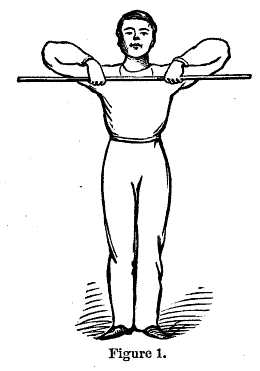
BY DIO LEWIS, M.D.,
PROPRIETOR OF THE ESSEX STREET GYMNASIUM, BOSTON.
WITH THREE HUNDRED ILLUSTRATIONS.
"By no other way can men approach nearer to the gods, than by conferring health on men." - CICERO.
THIRD EDITION
BOSTON:
TICKNOR AND FIELDS.
1862.
PREFACE.
This book describes and illustrates a new system of physical training. Like air and food, its exercises are adapted to both sexes, and to persons of all ages.
The new system has been introduced into female seminaries with complete satisfaction. Its beautiful games, graceful attitudes, and striking tableaux, possess a peculiar fascination for girls. Public classes, composed of adults of both sexes, elicit general enthusiasm. Children under three years of age are warmly interested, and improved in form and strength.
The exercises are arranged to music, and when performed by a class, are found to possess a charm superior to that of dancing and other social amusements, while the interest increases with the skill of the performers.
This system of exercises will correct drooping or distorted shoulders, malposition of the head, and many other common defects.
Its author has been engaged many years in teaching gymnastics. He began with a few simple exercises, and, making additions from time to time, has at length developed a very comprehensive system. Not one exercise is presented which has not been proved by long and varied use, while hundreds have been devised and rejected. Although the author has enjoyed during more than twenty years the discipline of the medical profession, its suggestions have not been adopted unless fully justified by experience in the gymnasium.
Efforts are being made to disseminate a practical knowledge of the new system. A college has been incorporated -the BOSTON NORMAL INSTITUTE FOR PHYSICAL EDUCATION, from which persons of either sex, after a full training, are graduated, with the honors of a legal diploma.
It is the ardent hope of the author that his humble labors may contribute something to the beauty and vigor of his countrymen.
PHYSICAL EDUCATION.
I have nothing to say of the importance of Physical Education.
He who has not seen in the imperfect growth, pale faces, distorted forms and painful nervousness of the American People, enough to justify any and all efforts to elevate our physical tone, would not be awakened by words, written or spoken. Presuming that all who read this work are fully cognizant of the imperative need which calls it forth, I shall enter at once upon my task.
My object is to present a new system of Gymnastics. Novel in philosophy, and practical details, its distinguishing peculiarity is a complete adaptation, alike, to the strongest man, the feeblest woman, and the frailest child. The athlete finds abundant opportunities for the greatest exertions, while the delicate child is never injured.
Dispensing with the cumbrous apparatus of the ordinary gymnasium, its implements are all calculated not only to impart strength of muscle, but to give flexibleness, agility and grace of movement.
None of the apparatus, (with one or two slight exceptions,) is fixed. Each and every piece is held in the hand, so that any hall or other room may be used for the exercises.
PUBLIC INTEREST IN PHYSICAL EDUCATION.
The true educator sees in the present public interest in physical education, a hope and a promise.
And now he is only solicitous that the great movement so auspiciously inaugurated, may not degenerate into some unprofitable speciality.
One man strikes a blow equal to five hundred pounds; another lifts eleven hundred pounds; another bends his back so that his head rests against his heels; another walks a rope over the great cataract; another runs eleven miles in an hour; another turns sixty somersets without resting.
We are greatly delighted with all these-pay our money to see them perform; but as neither one of these could do what either of the others does, so we all know that such feats, even if they were at all desirable, are not possible with one in a thousand. The question is not what shall be done for these few extraordinary persons. Each has instinctively sought and found his natural speciality.
But the question is, what shall be done for the millions of women, children and men, who are dying for physical training? My attempt to answer this momentous question will be found in this work.
DO CHILDREN REQUIRE SPECIAL GYMNASTIC TRAINING?
An eminent writer has recently declared his conviction, that boys need no studied muscle culture. "Give them," he says, "the unrestrained use of the grove, the field, the yard, the street, with the various sorts of apparatus for boys' games and sports, and they can well dispense with the scientific gymnasium."
This is a misapprehension, as is easy to convince all, who are disposed to think!
With all our lectures, conversations, newspapers, and other similar means of mental culture, we are not willing to trust the intellect without scientific training. The poorest man in the State denmands for his children the culture of the organized school; and he is right. An education left to chance and the street, would be but a disjointed product. To insure strength, patience and consistency, there must be methodical cultivation and symmetrical growth. But there is no need of argument on this point. In regard to mental training, there is, fortunately, among Americans, no difference of opinion. Discriminating, systematic, scientific culture, is our demand.
No man doubts that chess and the newspaper furnish exercise and growth; but we hold, and very justly too, that exercise and growth without qualification, are not our purpose. We require that the growth shall be of a peculiar kind-what we call scientific and symmetrical. This is vital. The education of chance would prove-unbalanced, morbid, profitless.
Is not this equally true of the body? Is the body one single organ, which, if exercised, is sure to grow in the right way? On the contrary, is it not an exceedingly complicated machine, the symmetrical development of which requires discriminating, studied management? With the thoughtful mind, argument and illustration are scarcely necessary; but I may perhaps be excused by the intelligent reader for one simple illustration. A boy has round or stooping shoulders: hereby the organs of the chest and abdomen are all displaced. Give him the freedom of the yard and street-give him marbles, a ball, the skates! Does any body suppose he will become straight? Must he not, for this, and a hundred other defects have special, scientific training? There can be no doubt of it!
Before our system of education can claim an approach to perfection, we must have attached to each school a Professor, who thoroughly comprehends the wants of the body, and knows practically the means by which it may be made symmetrical, flexible, vigorous and enduring.
MILITARY DRILLS.
Since we have, unhappily, become a military people, the soldier's special training has been much considered as a means of general physical culture. Numberless schools, public and private, have already introduced the drill and make it a part of each day's exercises.
But this mode of exercise can never furnish the muscle culture which we Americans so much need. Nearly all our exercise is of the lower half of the body-we walk, we run up and down stairs, and thus cultivate hips and legs, which, as compared with the upper half of the body, are muscular. But our arms, shoulders and chests are ill-formed and weak. Whatever artificial muscular training is employed, should be specially adapted to the development of the upper half of the body.
Need I say that the military drill fails to bring into varied and vigorous play the chest and shoulders? - Indeed in almost the entire drill, are not these parts held immovably in one constrained position? In all but the cultivation of uprightness, the military drill is singularly deficient in the requisites of a system of muscle training, adapted to a weak-chested people.
The exercises employed to invigorate the body, should be such as are calculated to make the form erect, and the shoulders and chest, large and vigorous.
Dancing, to say nothing of its almost inevitably mischievous concomitants, brings into play chiefly that part of the body which is already in comparative vigor, and which, besides, has less to do directly, with the size, position and vigor of the vital organs.
Horse-back exercise is admirable, and has many peculiar advantages which can be claimed for no other training, but may it not be much indulged, while the chest and shoulders are left drooping and weak?
Skating is graceful and exhilarating, but to say nothing of the injury which not unfrequently attends the sudden change from the stagnant heat of our furnaced dwellings to the bleak winds of the icy lake, is it not true that the chest muscles are so little moved, that the finest skating may be done with the arms folded?
I suggest these thoughts for the intelligent reader, and then take the liberty to request his careful examination of the "Ring" and other exercises which appear in this work. Are they not completely adapted to the obvious necessities of our bodies?
MUSIC WITH GYMNASTICS.
A party may dance without music. I have seen it done. But the exercise is a little dull.
Exercises with the upper extremities are as much improved by music as those with the lower extremities. Indeed with the former there is much more need of music, as the arms make no noise, such as might secure concert in exercises -with the lower extremities.
A small drum, costing perhaps $5, which may be used as a bass drum, with one beating stick, with which any one may keep time, is, I suppose, the sort of music most classes in gymnastics will use at first. And it has advantages. While it is less pleasing than some other instruments, it secures more perfect concert than any other.
The violin and piano are excellent, but on some accounts the hand-organ is the best of all.
Feeble and apathetic people, who have little courage to undertake gymnastic training, accomplish wonders under the inspiration of music. I believe five times as much muscle can be coaxed out, under this delightful stimulus, as without it.
TIlE GYMNASIUM.
The gymnasium must not be cold, but should be well ventilated. The best plan is to raise it to 65 or 68, and when the class begins, drop the upper sash of the windows, raising them again when the teacher announces a period of rest.
It is a common mistake to suppose that the gymnast should exercise in a cold room until he is warm. It is not difficult to accomplish this, but cold air is unfavorable to the development of muscle. My own rule is to make the hall as warm as for a lecture, and then open the windows freely during the exercise.
The floor of the gymnasium should be marked as shown in the cut. The lines must be about fifty-five inches apart, both lengthwise and crosswise of the room. The feet must have exactly the relations exhibited in the cut. A large piece of tin, cut out in the shape of a pair of feet, and laid on the floor at the right points, may be used with a stencil brush, to make the marks. The painters will furnish a black paint which contains no oil. It is very little trouble to mark a floor in this way.
With a floor thus marked, you have to make no explanations, either in regard to the position of each pupil on the floor, or the attitude of the feet, and you are sure to avoid all accidents.
It is very difficult to keep the floor of a gymnasium sufficiently clean, but it is better to refrain from gymnastic training altogether, than to expose the lungs of the pupil to a cloud of dust. Complete gymnastics involve much foot stamping, designed to invigorate the circulation in our feet and legs, which are generally cold. No feature of the exercises is more important. How shall freedom from dust be secured? In my own gymnasium, I have the floor cleansed with water three times a week. Scattering damp saw dust over the floor and sweeping it off, has been resorted to with satisfaction.
But if the floor have many cracks, they fill with dust, which the stamping will not fail to bring out. In such a case it is well to fill the cracks with wax, which, being melted, can be filled in with little difficulty. When the wax has been thoroughly cleansed from the upper surface of the boards, it will not work up from the cracks and make the boards slippery.
EXERCISES WITH WANDS.
A straight, smooth stick, one inch in diameter, and four feet long, (three feet for children) with round ends, is known in this Gymnasium as a "Wand," and is highly prized. It is used to cultivate flexibility, and is equally useful to persons of all ages and degrees of strength.
As a stiff, inflexible condition of the ligaments and muscles connected with the shoulders is the principal obstacle in the way of beginners, and as the wand is the best known means to remove this stiffness, it should be made prominent during the first few weeks or months of the training.
It is perhaps unnecessary to say that the symmetrical development of the upper half of the body turns entirely upon the freedom with which one can use the shoulder joint. This is sufficiently obvious, when we reflect that exercise of the body above the waist depends upon the arms, and of course upon the degree of freedom with which we can use the arms.
While it cannot be denied that certain muscles about the shoulders and chest may be developed to any degree, and the shoulders remain drooping and stiff, it is quite as undeniable that general and symmetrical development of that part of the body, (which is almost universally distorted and deficient among Americans,) can be achieved only by complete liberty about the shoulder joint, through which as a fulcrum or centre, all considerable training of the upper part of the body is derived.
I had pursued the study of Gymnastic Culture but a short time, before I saw the great importance of the wand, in a system of training adapted to the American people.
I have invented a very extended series of these exercises, some of which are here described and illustrated.
No. 1. Divide the wand into three equal parts with the hands, and hold it as represented in Fig. 1. Thrust it downward close by the legs with much force, and again bring it up by the chin, holding the elbows high as seen in the figure, and so continue twenty times.

No. 2. From the position seen in Fig. 1, carry the wand directly upward as high as you can reach, and back to the chin, ten times.
No. 3. From the highest position in No. 2, bring the wand down to the knees and back again, twenty times, without bending the elbows.
No. 4. Holding the wand high over the head, bring it down on the back of the neck, ten times, as seen in Fig. 2.

No. 5. Same as the last, except every second time the wand is brought down to the chin, being careful that every time that the wand is carried upward, it is carried as high as possible and with much force.
No. 6. Hands over the head, but this time at the ends of the wand, as seen in Fig. 3, and now bring it down behind as seen in Fig. 4, twenty times, being very careful not to bend the elbows.


No. 7. Same as the last, except that every second time the wand is brought down to the knees in front.
No. 8. Hold the wand directly over the head, hands grasping the ends, and carry it from side to side, (Fig. 5) being very careful not to bend the elbows, and yet the wand must come to the perpendicular on either side.
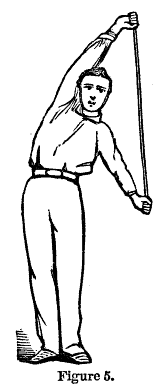
No. 9. Hold the wand directly in front and perpendicular, with the hands in the middle of it six inches apart, and the arms as nearly horizontal as possible; keeping the arms stiff, whirl the wand from side to side as far as you can.
No. 10. Standing erect, heels together, put the wand out with your right hand midway between two lines, one of which runs directly forward, and the other at right angles with this, at your side; which direction we shall call diagonally forward. Let the wand rest on the floor, at a point as far removed from your feet as possible, keeping your body and the wand perpendicular, and the arm horizontal. The elbow must not be bent. Step out as seen in Fig. 6, the foot passing behind the wand, as seen in the figure. In doing this you must not bend the elbow, nor must you move the wand. It will be seen that the shoulders scarcely move, the motion being confined to the legs and lower part of the body. Charge thus ten times.
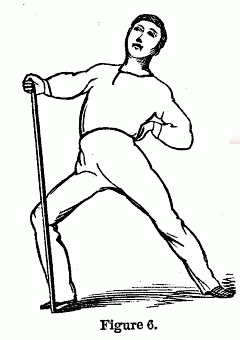
No. 11. Same as the last, but with the left hand and foot.
No. 12. Stand erect. Carry the wand out with the left hand diagonally forward, as far as you can reach. Step out to the wand with the left foot. Let the foot remain there. Now the body is to rise and fall as far as possible. (Fig. 7.) Don't bend the knee of the right leg. Keep the shoulders and head well back.

No. 13. Same as the last, on the right side.
No. 14. Stand as seen in Fig. 8. Thrust the arms straight forward, and back again to the chest, ten times, keeping the wand all the time perpendicular.

No. 15. At the conclusion of the last exercise, when the arms are thrust forward, bring the wand into the position seen in Fig. 9. Then carry it right back to the position in front, with the arms straight and horizontal. Now bring it down on the left side, and so continue ten times to each side.

No. 16. In concluding the last, when the arms are extended in front, bring the hands and wand to the position seen in Fig 8. Carry it out diagonally, forward and upward on the left side, as seen in Fig. 10. Bring it back to the chest again, and thrust it out to the right side. Alternate twenty times.

No. 17. As you thrust out the wand on the right side, step out the foot in the same direction. Be sure it is neither forward or at the side, but diagonally forward. (Fig. 11.) Alternate between the right and left side, twenty times.

No. 18. Same as the last, except the wand goes to the right as the left foot charges to the left, and the left arm and wand to the left, while the right foot charges to the right.
No. 19. Same as the last, except when the right foot charges diagonally forward, the wand is made to point diagonally backwards over the left shoulder, and vice versa.
No. 20. Same as the last, except when the right foot charges diagonally forward, the wand is made to point diagonally backward, over the right shoulder, and when the left foot charges diagonally forward, the wand is made to point diagonally backward, over the left shoulder.
No. 21. Same as the last, except the feet charge diagonally backward. As the left foot charges, thus, the wand is made to point diagonally forward, on the right side, and vice versa. (Fig. 12).
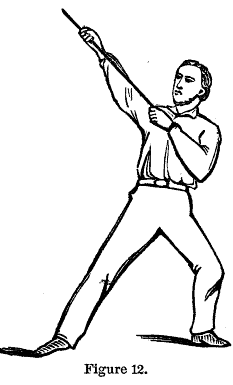
No. 22. Same as the last, except when the left foot charges diagonally backward, the wand is made to point diagonally forward on the left side, and when the right foot charges diagonally backward, the wand points diagonally forward, on the right side.
No. 23. Same as the last, except when the left foot charges diagonally backward, the wand points diagonally backward, on the same side. And when the right foot charges diagonally backward, the wand points diagonally backward, on the same side.
No. 24. Same as the last, except when the left foot charges diagonally backward, on its own side, the wand points diagonally backward, on the right side, and vice versa.
It must not be forgotten that in all these compound exercises, involving the action of the arms and legs, the wand is always held at an angle of 45 degrees above the horizontal; and that in every case in passing from one charge to another, the wand is brought to the position represented in Fig. 8. Without this it would be impossible to keep time to the music. Let the steps be as long as possible.
No. 25. Wand horizontal over the head, as seen in Fig. 3. As in almost all the wand exercises, be careful not to bend the elbows. Turn the wand round so that the right hand comes exactly in front, and the left hand exactly behind. Bring the left in front and the right behind, so change twenty times.
No. 26. Hold the wand horizontal over the head, with the right hand in front and the left one behind. Make, by the side of the body, the motion seen in paddling a canoe. Each time carry the wand so far back that it shall be perpendicular. Do this ten times on the right side; then ten times on the left; then alternately ten times. Each time, as the wand is brought over the head it must be made horizontal, with one hand exactly in front, and the other behind, and as it is brought behind the body, it must be made perpendicular.
No. 27. Charge diagonally forward with the right foot; wand in the same direction. Left foot diagonally forward; wand the same. Left foot diagonally backward; wand the same. Right foot diagonally backward; wand the same. Having thus gone all around, begin again with the left foot and go round the other way in like manner.
No. 28. With both hands take hold at the end of the wand. Hold it horizontal in front. Carry it directly backward without bending the arms, as seen in Fig 13. (I see the Artist has tipped the figure so far that the centre of gravity is lost.)
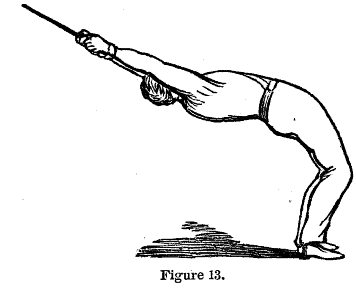
No. 29. Heels together. Wand directly in front, resting on the floor, and perpendicular. Arm straight. Step the right foot forward to the wand, and back to the other foot, five times. Left foot the same.
No. 30. Step the right foot backward as far as you can reach, (Fig. 14.) and bring it back to the other foot, ten times. Same with the left foot.
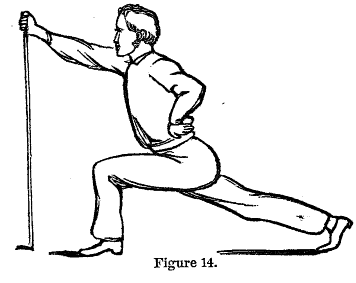
No. 31. Carry the right foot forvard to the wand. Returning, do not stop by the other foot, but carry it backward as far as you can reach. Now forward to the wand again. Make this long sweep ten times. Left foot the same.
No. 32. Seizing the upper end of the wand with both hands, as seen in Fig. 15, carry the right foot forward to the wand, and the left foot back as far as you can reach. Change them at a single jump, and so continue ten times.
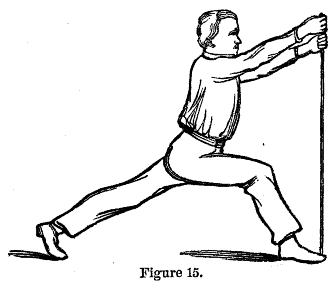
No. 33. Hold the wand in the position seen in Fig. 9, on the right side, with the right hand at the lower end, and the left hand at the upper. Change it to the left side, with the left hand at the lower end, and the right hand at the upper; so change from side to side, ten times.
No. 34. Begin the same as in the last, except the wand is held on the back of the right shoulder instead of the front. Carry it now to the back of the left, and so alternate ten times.
No. 35. Beginning at the front of the right shoulder, as in No. 32, carry it to the front of the left shoulder. Then to the back of the left shoulder, and now to the back of the right shoulder. Go thus around the body five times.
No. 36. Begin at the front of the left shoulder, and go around the body the other way five times.
No. 37. Hold the wand on the front of the right shoulder. Carry it to the back of the left shoulder. Back again to the front of the right shoulder. Repeat ten times.
No. 38. Begin at the front of the left shoulder, and alternate with the back of the right shoulder.
No. 39. Again putting the wand in front, on the floor, perpendicular, with the right hand seizing the upper extremity, and the arm straight, step the right foot forward to the wand. Bring it back to the other foot. Now step sideways to the right as far as you can reach. Bring it back to the other foot again; now step backward as far as you can reach. Bring it back to the other foot. Still using the right foot, step sideways to the left as far as you can reach, passing it by the left leg behind, (Fig. 16.) now back to the other foot again. Pass it to the left again, in front of the left leg, (Fig. 17.) and bring it back to the other foot. Continue this round five times.
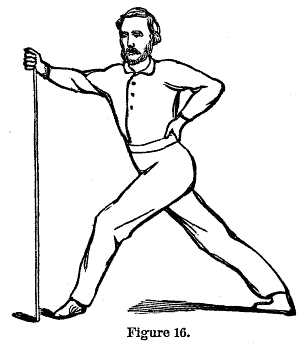

No. 40. Same with the left arm and leg five times. In all this the wand must not loose its perpendicularity.
No. 41. Stand up right, with the heels to gether, seize the wand at its middle, with the right hand, and hold the arm horizontal in front-wand perpendicular. Keeping the arm in the horizontal place, whirl it round the body, making a complete circle, but do not stir the feet. Same with the left hand, ten times.
No. 42. Grasp the middle of the wand with both hands, and whirl as in the last, as far as you can, ten times.
No. 43. Same as the last, except the wand is held horizontal, instead of perpendicular.
No. 44. Seizing the wand as seen in Fig. 18, step backward and forward over it with the right and left foot, ten times.
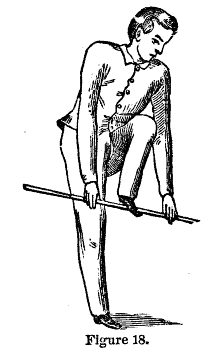
No. 45. Stand upright, heels together, grasp the wand at the extreme ends and hold it behind the body, keeping the arms straight. The right hand high up, and the left hand low down. Now swing the left hand high up, and the right low down, and so continue to change the relative positions of the ends of the wand, without bending the elbows, ten times.
No. 46. Charge the right foot diagonally forward, as seen in Fig. 19, five times. Now the left foot with the left hand raised high, five times. Alternate five times.
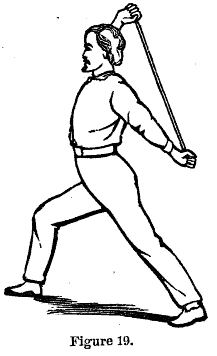
No. 47. Same as the last, except that when charging with the right foot, you raise the left hand high, and vice versa. The wand exercises from this point are performed in couples, and while marching.
No. 48. Marching as represented in Fig. 20, leap sideways as far as possible, first one foot, and then the other, without loosing your relation to each other.
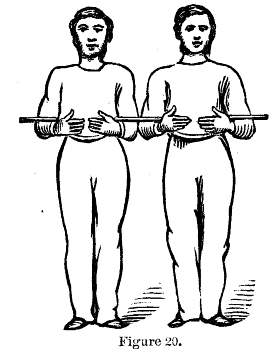
No. 49. Putting the two wands together, and holding them as represented in Fig. 21, leap sideways as before, being sure to keep the shoulders back, and so leaping together, that the two will move as one person. Be sure to keep the arms quite perpendicular over the shoulders.
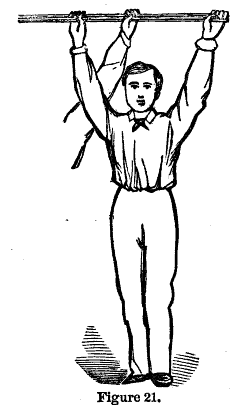
No. 50. One person walking directly behind the other, take hold of the extreme ends of the wands, and then allow the hands to rest on the shoulders. Marching in this way, at the word of command, "Up," raise the wands as high as you can, and as the right foot goes forward, thrust the right hand as far forward as possible, the left one at the same time being pushed as far back as possible, (Fig. 22.) and as the left foot comes forward reverse the hands.

No. 51. Same as the last, except the right hand goes forward with the left foot, and the left hand with the right foot. In all these you must not bend the elbows, except when you are told to bend them.
No. 52. Still keeping your arms perpendicular, carry both of your hands forward as far as you can reach, with your right foot, and as you step your left foot forward, carry both hands as far back as you can reach, and thus continue for ten steps.
No. 53. Same as the last, except that the hands go forward with the left foot, and backward when the right foot goes forward.
No. 54. Bring the hands to the shoulders, and as the right foot steps forward, raise the right hands as high as you can reach. When the left foot goes forward raise the left hands, and bring down the right hands, and so continue to alternate ten times.
No. 55. Same as the last, except the right hands go up as the left feet go forward, and the left hands with the right feet.
No. 56. The two hands go up simultaneously with the stepping forward of the right feet, and come down as the left feet go forward.
No. 57. Same as the last, except the hands go up as the left feet go forward, and down as the right feet go forward. Be sure in the last four exercises that the arms go up and down quite vertically.
No. 58. Put the two wands together and take hold of them with one hand, as represented in Fig. 23, and marching side by side, leap sideways right and left, keeping the wand as high as you can reach.

No. 59. Partners change sides and repeat the same.
No. 60. Carrying the wands as in Fig. 23, as you step forward with the right foot, bring the wand down so as to strike your right leg with the hand, and then as your left foot goes forward, carry the wand back to its vertical position, and so continue ten times.
No. 61. Change sides with your partner, and do the same again, only bringing your wand down as the left foot goes forward, and raising it as the right foot goes forward.
No. 62. Cross the hands on the two wands placed side by side, but instead of holding them over the head, as in Fig. 21, let them hang down in front, and carrying them thus, leap from side to side.
No. 63. Walking one in front of the other, and extending the arms horizontally, being careful not to bend the elbows, carry the right forward as far as possible with the right foot, as represented in Fig. 24, and simultaneously with this, carry the left foot backward, as far as possible. When the left foot comes forward, let the left hand come forward too, and thus alternate.
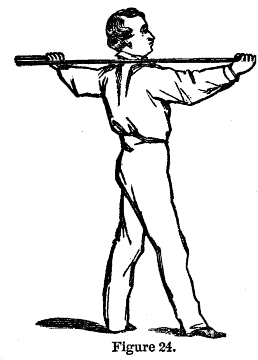
No. 64. Same as the last, except that the right hand comes forward with the left foot, and vice versa.
No. 65. The same simultaneously with the right foot, and with the left foot. Be careful in the performance of the last four, that you keep the arms exactly horizontal from first to last.
No. 66. Walking, one in front of the other, with the wands hanging in the hands on either side, carry one up as high as you can reach, as in Fig. 25, and then as the other foot goes forward, carry up the other while the first is brought down.
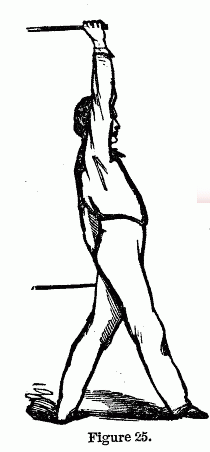
No. 67. Same as last, except the right arms go up as the left foot goes forward, and vice versa.
No. 68. Simultaneously up with the right foot forward ten times, and the same with the left foot.
It is perhaps unnecessary to repeat that every motion with the wands is to be done to music. In making the changes from one exercise to another, this rule must not be forgotten.
It must not be forgotten that the feet, in every exercise, are to be kept at a right angle with each other.
It is hardly necessary to say that teachers may add to this series at pleasure. It is not difficult to extemporise a few exercises which are exactly adapted to some unusual circumstance, as for example a crowded room, or some peculiar position of the seats.
I have the wands made hollow sometimes, and loaded with a small mass of iron, or a pound or two of shot, which, moving from end to end, serves with a slight noise to mark the time, and add to the force of the exercises.
The shorter the wand the more difficult the exercise; so when a pupil has made some advance and feels himself competent to severer labor, direct him to seize the wand at a little distance from the end. By drawing in the hands a few inches at either end, he will add greatly to the difficulty of the feats.
If once a month the wands be well rubbed with sand paper, they will be kept smooth and neat.